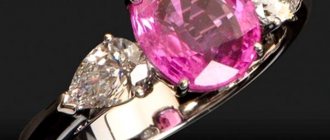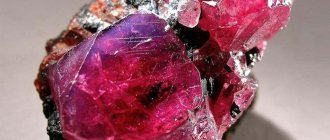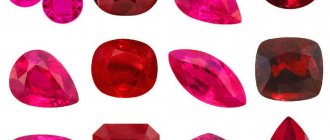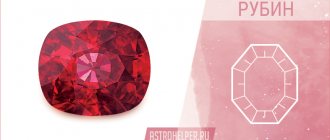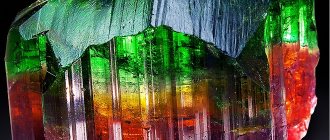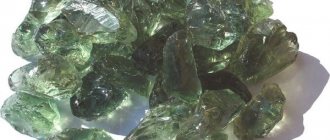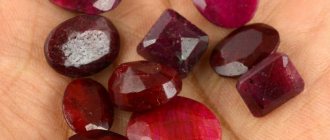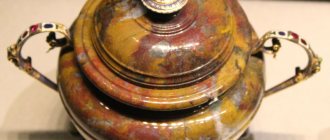Pyrope is a fossil transparent mineral of a fiery red color, which is widely used by jewelry craftsmen to make expensive exclusive jewelry: pendants, earrings, bracelets, tiaras. Gemologists greatly value this gemstone, which is the pride of a high-end jewelry collection.
In jewelry of artistic quality, passed down by inheritance in noble families, the use of a noble wine-colored gem was very popular. Jewelry pyrope, supporting the mythical aesthetics of mystery, was inlaid into clasps - clasps made of precious stones.
History and origin
The term “pyrope” translated from ancient Greek into Russian means “fire-like” and was attributed to the patronage of the god of war, Mars. In modern international classifiers this precious mineral is called “Pirope”.
In the Mongolian epic, pyropes are “magnified” by frozen fragments of volcanic fire and frozen drops of dragon blood. Fire garnet jewelry crystals are excellent as blanks for cutting and making decorative inserts in jewelry.
In 1038, the great scientist Biruni, who lived in Khorezm, wrote a book on mineralogy, which described the fire garnet and the significance of this mineral for humans. In romantic images, the author compares pyrope with a candle flame, a pomegranate seed, a drop of wine, praising its delightful color.
The silky shine of crystalline pyrope is misleading, since in ancient times this crystal was confused with Ruby, noble Spinel, Tourmaline - precious minerals of a similar shade.
For a long time, all transparent fossil red crystals were called the general term “lal”, which corresponded to the name of the Pamir deposit where the red nugget was first mined. The stone looks very solemn, ceremonial and representative. In Indian folklore, pyrope is poetically called “grape pomegranate” for its thick purple color.
Myths and legends
Very often, pyrope is not even called garnet, but Czech (Bohemian) ruby. This inconsistency is due to the fact that the first samples of an unusual mineral, a scattering of fiery red stones, were found in the mountains of the Czech Republic by simple peasants. This happened during the Middle Ages, in the 10th century. In 1546, the alchemist, warlock Gregory Agricola, conducted experiments with a gem, which, when exposed to sunlight or reflections from a candle, flared up with a bright flame, and in the shadows or under weak artificial lighting it became purple-black. It was he who called it pyrope, that is, similar to fire, from the Greek word pyr - fire.
In 1803, the scientist geologist and mineralogist Werner Abraham Gottlob (Germany) studied the properties of a sample of Czech garnet. It was he who isolated it as a separate type of mineral and gave it the official (scientific) name pyrope - pyrope.
However, people knew about this stone before. Even in ancient times, the Hellenes already used the name pyropos to designate it. The Latins called it, like all red stones, a carbuncle, which translates as a smoldering coal. He was associated with the name and power of the god of war, Mars. When Roman legionaries went on a campaign, they always took amulets, talismans, or just pieces of stone with them, so that it would bring them good luck, send them luck and courage in battle.
Among the myths of Ancient Greece there is a story telling about an evil and treacherous echidna woman. She was a beautiful girl, whose lower body resembled a crocodile. A large fiery stone adorned her forehead. The legend said that its owner would be able to find any treasure, no matter how carefully it was hidden. Many knights who tried to steal the stone were killed by an echidna, who ate them along with their armor.
According to another legend that originated in Medieval Europe, pyrope is the frozen blood of a dragon. Having defeated the dragon, the warrior must cut off its head and remove from the skull a luminous blood clot, which immediately solidifies, turning into stone - pyrope. Having given the gem to the lady of his heart, the brave knight could count on her favor. Other warriors decorated their weapons with it: seeing a bright red garnet shining on the hilt of a sword, other knights were afraid to engage in battle with him, because he was able to defeat even a dragon.
Some dishonest people tried to steal the trophy in order to appropriate it for themselves or resell it. But the stone, which was considered a symbol of courage, courage, justice, honor, began to harm the kidnapper, as well as the person who acquired it in such a “dishonest” way.
Our ancestors were also familiar with red stone. Venice or the worm, which “glows at night” and is “visible like coal,” as pyrope was described in the ancient ABC book, came to Ancient Rus' from the Mongols. Galyn Chulu is a stone of fire, Tamerlane’s warriors called it. They considered it the sparks of a volcano, giving strength and courage. Before the battle, they always drank a drink from a bowl decorated with pyrope.
Place of Birth
The natural gem belongs to the group of garnets, which are mined in kimberlite pipes - channels of volcanic origin filled with rock with a high concentration of various minerals.
Natural crystals of the mineral are mined in deposits located in the mountainous region of the Czech Republic, in Russian Yakutia, and the Ukrainian Azov region. On the African continent, kimberlite pipes are found in Lesotho and Tanzania.
Pyropes are found in Brazil, the USA, Australia, as well as in the depths of Norwegian mines in the form of phenocrysts of the main abrasive rock. Fossil wine garnets are quite small - no more than ten millimeters in length, and often “grow together” with diamonds - their natural companions.
Physical properties
Red garnet has a rich fiery color, the “density” of which depends on the quality of the rock impurities present in the crystal mass. The red color of a natural stone is given by chromium molecules, therefore, the higher the percentage of this element, the darker the color of the nugget.
Also read: Rhyolite - a rock from fossilized ancient volcanoes
| Properties | Description |
| Formula | Mg3Al2(SiO4)3 |
| Impurity | Mn, Cr, Fe |
| Hardness | 7,5 |
| Density | 3.65 - 3.84 g/cm³ |
| Transparency | Transparent, translucent. |
| Kink | Uneven. |
| singonia | Cubic (Planaxial). |
| Color | Red, blood red, orange-purple, pink. |
Druses mined in garnet mines are mixed mineral aggregates that have an almost black tint with inclusions of “fused” diamonds and garnets. Fossil garnet gems in nature look like a handful of smoldering coals taken from a home fire.
Mineral - chameleon
Pyrope crystals with the alexandrite effect (reverse) have exclusive value, as they have the rare property of creating an optical illusion. Reverse is a change in the color of the stone, depending on the type of illumination:
- daylight brings out the pale emerald hue of the stone;
- electric lighting changes the color of the crystal from green to pink;
- the light of a candle flame “colors” the precious mineral with a mysterious purple.
The unique alexandrite effect of pyrope, a chameleon gem, is of high value in jewelry. Faceted red garnets are inlaid into designer products of experienced craftsmen, which have a high commercial price and market popularity.
Pyrope contains a small amount of iron molecules - unlike almandine and rhodolite, which have a high percentage of the metal.
Colors
The main color is always red. The most popular are wine-colored stones (relatively dark, with a slight hint of pink or purple). The most common are blood red and tan stones. There are also several other colors:
- purple;
- brown-red;
- pink;
- brown;
- dark burgundy.
Dark minerals are often used in jewelry. It is believed that such representatives look especially impressive and have the most powerful impact. Dark brown, almost black specimens are rare. Of particular value are minerals with the effect of alexandrite, which change color depending on the lighting.
Medicinal properties
In ancient Indian treatises, pyrope is described as a healing stone that normalizes circulatory functions, improves blood formula, and regulates blood pressure. The dual biofield of pyrope with a two-faced reverse corresponds to two types of blood circulation: arterial and venous.
It can be assumed that the morning sunlight reflected in the “bloody” pomegranate stimulates arterial blood circulation, and the refracted electric light flux supports the venous circulation of the body.
Pyrope nourishes the cardiovascular system, the respiratory system of the body, strengthens the immune system and the general condition of the patient. A healthy person is not recommended to constantly wear jewelry with a stone, since a stone with an active field can cause energy oversaturation and excessive excitability.
Female assistant
In the folklore of eastern countries, bright pyrope is glorified as a protective mineral for expectant mothers. Red pomegranate is given to pregnant women for regular wear (three hours a day) to facilitate childbirth, as well as the birth of a healthy baby.
Sorcerers - lithotherapists who have secret knowledge, recommend that pregnant women wear a pomegranate amulet in the abdominal area.
History of pyrope stone
Pirov has long been used in the manufacture of jewelry.
The mineral has been known since ancient times. Different peoples gave pyrope their own name. There were stories and legends about him. Poems were even dedicated to the stone. When studying ancient manuscripts, one can find descriptions of it. It received its official name in the 13th century. The characteristics and properties of pyrope were described by a medieval alchemist. According to one version, it arose as a result of a magma eruption. In ancient times, it was believed that the mineral was frozen fire or the blood of fire.
Pyrope became especially popular during the heyday of travel companies. Representatives of the European elite began to purchase jewelry made of stone. Attractive products became increasingly famous. The lovers fell in love with this gem.
Pyrope of a rich red hue was used in jewelry of the 18th-19th centuries.
Magic properties
Czech pyrope has ruby red hues and is considered a symbol of love passion. Numerous tourists visiting Bohemia actively purchase souvenirs with inlays of pomegranate seeds as gifts for loved ones.
Also read: Heliolite - why is it a sun stone?
The Czech national women's costume uses garnet beads as a decorative element and enhances attractiveness. Myths of folklore endow fiery red garnet with properties that kindle feelings of love and the creation of a happy family.
In magical practice, it is believed that the main quality of pyrope is strengthening the mental and physical body, enhancing sexual attractiveness and male potency. These magical powers are attributed to all magical pyropes stones, which have the ancient name “lal”:
- Rhodolites;
- Pyropam;
- Almandin.
To create a happy family, a girl must wear a ring with a Bohemian ruby on her left hand. A young gentleman can become a happy groom by periodically wearing a ring with a stone on his right hand. Jewelry is given to loved ones to create individual magical protection from the effects of negative energies.
Grape pomegranate supplies its owner with additional energy and tunes the subtle structures of the bio-field for combat or romantic achievements.
Applications
Pyrope, along with other garnets, is very easy to process.
In addition, it is widely distributed and therefore an inexpensive gem. The best examples for use in jewelry are Czech stones, the so-called “Bohemian garnets.” She began making jewelry with them back in the 10th-11th centuries. In addition, some pyropes are very similar in color to rubies. Jewelers came up with the idea of calling them Arizona, Cape, and Bohemian rubies and at the same time raising their prices.
Pyrope can also be transparent, but in this case they are not used in jewelry, but are used as an abrasive material.
Jewelry with mineral
Jewelry of historical value is kept in Czech museums, in the region where Bohemian garnets are mined. It is known that the German poet Goethe gave his beloved a romantic gift - a garnet set consisting of a necklace, earrings, a garnet bracelet, a ring and a brooch.
Pyrope is often confused with ruby, since it can be impossible to distinguish these crystals visually.
Price lists of pomegranate jewelry
Jewelry of modern design, with inserts of small cabochons, mined in garnet mines, has a low cost. The average price of garnet jewelry depends on the design, as well as the number of cut pyrope inserts: approximately, one carat of garnet jewelry costs 1,500-2,000 rubles. The commercial price tag of a popular piece of jewelry can cost from 5,000 to 15,000 rubles.
Pyrope is a fairly inexpensive stone, so it is rarely counterfeited. But Bohemian garnets - pyropes, which are sold in tourist places in the Czech Republic, are mostly synthetic, since the deposits of this region have been depleted, so natural gems of jewelry quality have become rare.
In many cases, decorative inserts are made of common colored glass, so you can buy these decorations at a budget price.
Recommendations for purchasing jewelry
Natural gems are mined in smaller quantities, as some deposits are gradually depleted, so the investment attractiveness of jewelry increases.
When purchasing products with natural stones, you must ensure that you have a certificate or sales receipt with a detailed description of the crystal insert.
Also read: Almandine is a common variety of garnet
Scope of application and characteristics
Essentially, pyrope is quartz composed of chromium, aluminum, iron and magnesium. Due to chromium, magnesium and iron, the stone acquires a rich, bright color.
Crystals are used to make:
- decorative items;
- jewelry;
- abrasive raw materials in the industrial sector.
View this post on Instagram
Posted by Elena (@bezdelushkadlya) Jan 11, 2021 at 9:41 am PST
Brief dossier on the gem:
- hardness index – 7.5 on the Mohs scale;
- density indicator - 3.6-3.8 g per cm3;
- uneven fracture;
- presence of shine (transparent or glass);
- a characteristic optical effect (reverse or cat's eye, which depends on the lighting and the color of the stone itself).
Important! Pyrope does not change its color under the influence of high temperatures, which is why it is nicknamed the “immortal mineral.”
To imitate pyrope I use painted glass. Natural stone can be distinguished from it by the following criteria:
- uneven color;
- heavy weight;
- resistance to scratches and chipping;
- small sizes (the crystal cannot be large).
In the jewelry industry, artificial pyrope is also used, which is identical in properties to natural pyrope (same hardness, color and purity). Such stones are grown in laboratory conditions. Only professionals can distinguish an artificial specimen from a natural one.
INTERESTING: What is heliotis?
In order not to overpay for an analogue of a gem, ask the jewelry seller for a certificate confirming the authenticity of the insert. Unscrupulous retailers sell pyrope under the guise of red spinel or ruby (the stones are much more expensive).
How to distinguish a fake?
Unique single crystals undergo gemological examination and receive a final certificate, which indicates the quality characteristics and history of the origin of the stones. Such documentary support guarantees the authenticity of the purchased stone.
Practical recommendations for determining the authenticity of a stone
Natural pyropes are scatterings of small garnet “seeds” included in the rock, so they are not large.
Commercial offers of large crystals should cause a healthy mistrust; the need to verify the presented certificate or undergo a laboratory examination.
It is easy to distinguish a fossil crystal from a fake using a lens. Glass fakes have the same color over the entire area of the stone mass, but natural crystals are not evenly colored. This is the main feature of any fossil gem.
Using scales and a magnet, the origin of pyrope cannot be determined, since this method is used to determine the authenticity of crystals containing iron inclusions in their mass. Grape pomegranate does not contain iron in its composition, therefore it does not react to magnetic attraction.
Colors and varieties of pyrope stone
The pyrope stone is varied in shades.
The scientist Biruni was involved in describing the external appearance of pyrope. They compiled striking comparisons of its colors. He called the tones of the mineral the color of the grains of a ripe pomegranate, the reflection of a dying coal in a fireplace and a candle flame, as well as the petals of a pomegranate tree.
Caring for stone products
Jewelry with garnet inlays should be periodically wiped with a flannel cloth. Within six months, the product must be washed twice in warm soapy water and saline solution.
Accuracy and caution in the use of pyrope are of great importance, since after prolonged use the crystal may crack.
Interesting Facts
There are many interesting facts associated with pyrope:
- Czech crystals have been mined since the Middle Ages, when they were valued on a par with Burmese rubies.
- The largest pyrope mined weighed 633 carats.
- The Dresden Museum houses a sample weighing 468.5 carats.
- Russian queens and noblewomen highly valued jewelry with this mineral.
- Johann Goethe gave the girl he liked a set inlaid with garnets.
Due to the lack of special research methods, jewelers and scientists for a long time could not distinguish between rubies, pyropes and other red minerals.
Compatibility with names and zodiac signs
Fire garnet belongs to the group of “red” gems - lalas, which are under the protection of the warlike planet Mars, Venus and the constellation Orion. The astrological properties of pyrope contribute to the psychological increase in self-esteem, performance, concentration and organizational abilities of its owner.
Table accessories decorated with garnet inlays set a businessman up for successful business and achieving high financial results.
The precious gem favors the following zodiac signs:
- Leo.
- Scorpio.
- Aquarius.
- Capricorn.
The star patron, the fire garnet, supplies its wards with energy, sexual attractiveness, passion, confidence, and victorious vibrations. These zodiac signs, to whom this jewel is suitable, can actively use the blessed Bohemian ruby.
Garnet minerals go well with other natural crystals belonging to the friendly elements of fire and air.
Coincidence of constellations and names
The fire stone pyrope is the patron saint of people born under the fire signs of the zodiac. These are Leo, Sagittarius, Aries. Talismans and amulets with a red stone are suitable for them. With the power of magic, minerals attract good luck, help in business and in discovering talents.
The fiery planet Mars is a satellite of Scorpios, so jewelry with blood-red pyrope is also suitable for them. And for other water signs (Pisces, Cancer) the energy of the stone is useless. Here water wins and extinguishes the fire.
The stone is suitable for people with the names Anton, Tamara and Lyudmila. Owners of the jewelry acquire fearlessness and passion. In the male line, the mineral will help to open up as he grows up, especially if the boy was limited in his actions as a child.
An amulet with pyrope will protect Mary from everyday sadness. If this name coincides with the birth sign Leo, the power of the stone is limitless and will bring happiness. If the name is associated with the constellation Scorpio, then the girl will gain self-confidence. To get harmony in feelings from a mineral, you must be born under the sign of Gemini.
